
Blackface is a form of theatrical makeup used predominantly by non-Black people to portray a caricature of a Black person.
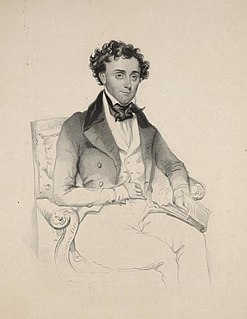
Thomas Dartmouth Rice was an American performer and playwright who performed in blackface and used African American vernacular speech, song and dance to become one of the most popular minstrel show entertainers of his time. He is considered the "father of American minstrelsy". His act drew on aspects of African American culture and popularized them with a national, and later international, audience.
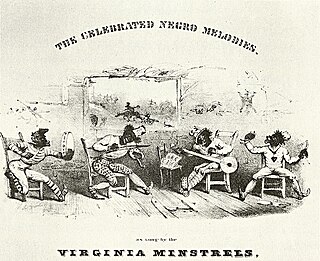
The minstrel show, also called minstrelsy, was an American form of racist theatrical entertainment developed in the early 19th century. Each show consisted of comic skits, variety acts, dancing, and music performances that depicted people specifically of African descent. The shows were performed by mostly white people wearing blackface make-up for the purpose of playing the role of black people. There were also some African-American performers and black-only minstrel groups that formed and toured. Minstrel shows caricatured black people as dim-witted, lazy, buffoonish, superstitious, and happy-go-lucky.

Charles Dibdin was an English composer, musician, dramatist, novelist, singer and actor. With over 600 songs to his name, for many of which he wrote both the lyrics and the music and performed them himself, he was in his time the most prolific English singer-songwriter. He is best known as the composer of "Tom Bowling", one of his many sea songs, which often features at the Last Night of the Proms. He also wrote about 30 dramatic pieces, including the operas The Waterman (1774) and The Quaker (1775), and several novels, memoirs and histories. His works were admired by Haydn and Beethoven.

Master Juba was an African-American dancer active in the 1840s. He was one of the first black performers in the United States to play onstage for white audiences and the only one of the era to tour with a white minstrel group. His real name was believed to be William Henry Lane, and he was also known as "Boz's Juba" following Dickens's graphic description of him in American Notes.
Isaac Bickerstaffe or Bickerstaff was an Irish playwright and Librettist.

Othello is a 1965 film based on the National Theatre Company's staging of Shakespeare's Othello (1964-1966) staged by John Dexter. Directed by Stuart Burge, the film stars Laurence Olivier, Maggie Smith, Joyce Redman, and Frank Finlay, who all received Oscar nominations, and provided film debuts for both Derek Jacobi and Michael Gambon.
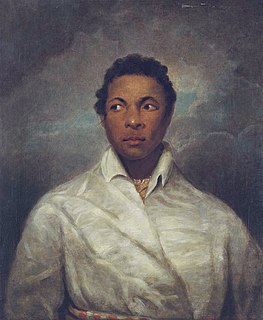
Ira Frederick Aldridge was an American-born British actor, playwright, and theatre manager, known for his portrayal of Shakespearean characters. James Hewlett and Aldridge are regarded as the first Black American tragedians.
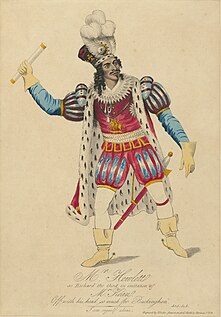
The African GroveTheatre opened in New York City in 1821. It was founded and operated by William Alexander Brown, a free black man from the West Indies. It opened six years before the final abolition of slavery in New York state. The African Grove Theatre was attended by "all types of black New Yorkers -- free and slave, middle-class and working-class" along with others. It was the first place where Ira Aldridge, who would later become an esteemed and renowned Shakespearian actor, first saw a production of a Shakespeare play.

"Old Dan Tucker," also known as "Ole Dan Tucker," "Dan Tucker," and other variants, is an American popular song. Its origins remain obscure; the tune may have come from oral tradition, and the words may have been written by songwriter and performer Dan Emmett. The blackface troupe the Virginia Minstrels popularized "Old Dan Tucker" in 1843, and it quickly became a minstrel hit, behind only "Miss Lucy Long" and "Mary Blane" in popularity during the antebellum period. "Old Dan Tucker" entered the folk vernacular around the same time. Today it is a bluegrass and country music standard. It is no. 390 in the Roud Folk Song Index.

Joel Walker Sweeney, also known as Joe Sweeney, was an American musician and early blackface minstrel performer. He is known for popularizing the playing of the banjo and has often been credited with advancing the physical development of the modern five-string banjo.
"Clare de Kitchen" is an American song from the blackface minstrel tradition. It dates to 1832, when blackface performers such as George Nichols, Thomas D. Rice, and George Washington Dixon began to sing it. These performers and American writers such as T. Allston Brown traced the song's origins to black riverboatsmen. "Clare de Kitchen" became very popular, and performers sometimes sang the lyrics of "Blue Tail Fly" to its tune.

Hokum is a particular song type of American blues music—a humorous song which uses extended analogies or euphemistic terms to make sexual innuendos. This trope goes back to early blues recordings and is used from time to time in modern American blues and blues rock.
"Miss Lucy Long", also known as "Lucy Long" as well as by other variants, is an American song that was popularized in the blackface minstrel show.
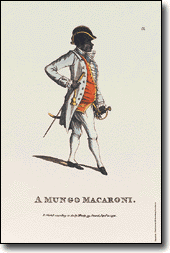
Julius Soubise was a formerly enslaved Afro-Caribbean man and a well-known fop in late eighteenth-century Britain. The satirized depiction of Soubise, A Mungo Macaroni, is a relic of intersectionality between race, class, and gender in eighteenth-century London. His life of luxury as a free man of colour allowed him to excel in elite activities such as fencing and made him notorious in London's social scene as an exception to norms.

Tom show is a general term for any play or musical based on the 1852 novel Uncle Tom's Cabin by Harriet Beecher Stowe. The novel attempts to depict the harsh reality of slavery. Due to the weak copyright laws at the time, a number of unauthorized plays based on the novel were staged for decades, many of them mocking the novel's strong characters and social message, and leading to the pejorative term "Uncle Tom".

Charles Isaac Mungo Dibdin, or Charles Pitt or Charles Dibdin the younger, as he was professionally known, was an English dramatist, composer, writer and theatre proprietor. He was perhaps best known for his proprietorship of the Sadler's Wells Theatre and for the pantomimes and satirical farces that he wrote, and which were staged at many theatres across London. He employed Joseph Grimaldi at Sadler's Wells where Grimaldi appeared in many of his most successful pantomimes. He was the son of Charles Dibdin, brother of Thomas John Dibdin and godson of David Garrick.
Harlem Duet is a 1997 dramatic play by Canadian playwright Djanet Sears. Billie, a young graduate student in Harlem, deals with her husband Othello leaving her for a white woman named Mona. The play moves through time to show Billie and Othello's relationship being torn apart by racial tensions at a Southern US cotton plantation in 1860, and in Harlem in 1928 and the present. Though the characters draw inspiration from Shakespeare's play Othello, Billie and the story are original creations.














